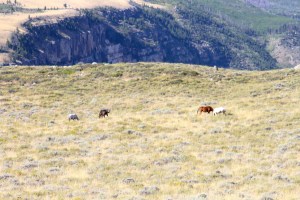LITTLE WIND RIVER DRAINAGE—Driving into the foothills west of Fort Washakie to tour experimental cheatgrass treatments, Art Lawson’s attention landed instead on the verdant vegetation he saw in every direction and something that he didn’t see at all — free-roaming horses.
The landscape he was driving though had immediately, dramatically rebounded following a massive roundup of the non-native equines in late 2023.
“Almost overnight results, really,” said Lawson, who directs Shoshone and Arapaho Fish and Game, which manages wildlife on the Wind River Indian Reservation.
“The mule deer that I’ve seen since we removed horses is unreal,” he added. “Really, deer [numbers] I haven’t seen in 10 years.”
Art Lawson on the Wind River Indian Reservation west of Fort Washakie in June 2024. (Mike Koshmrl/WyoFile)
There was no doubt in Lawson’s mind that the Wind River Indian Reservations’ many thousands of feral, free-roaming horses are what displaced mule deer and an array of other native species.
“We used to drive around and see horses,” Lawson said during the June outing. “Now we can drive around and see wildlife.”
Adaptable, hardy and unencumbered by predation, horses can double their population every four years. On the reservation, they were “growing in unreal numbers,” Lawson said, and obviously damaging the landscape’s ecological integrity.
“The cheatgrass that’s leftover after horses have been there for a while, it’s horrible,” Lawson said. “There’s no nutrition in cheatgrass.”
Some 7,600 free-roaming horses were rounded up and removed from the Wind River Indian Reservation in 2023 and 2024. Pictured, two mustangs graze the reservation in September 2023. (Mike Koshmrl/WyoFile)
Free-roaming horses’ dominance over the Wind River Range’s eastern foothills peaked just before last year’s roundup. In late fall 2022, a first go at an aerial survey found 5,500 horses on 1 million acres of the reservation — roughly half the land area within the boundaries. That didn’t account for animals the survey missed or foals born into the herd the following spring.
“We felt pretty confident there were at least 9,000 horses out there at that time,” said Pat Hnilicka, the supervisory biologist for the U.S. Fish and Wildlife Service’s Lander office.
The estimate was “very shocking,” he said.
Nationally, there were an estimated 73,520 free-roaming horses and burros as of March. At that time, the Bureau of Land Management estimated that there were 10,264 animals in its Wyoming herd management areas — which means the reservation housed almost as many feral horses as the rest of the state combined.
U.S. Fish and Wildlife Service staffer Pat Hnilicka on the Wind River Indian Reservation west of Fort Washakie in June 2024. (Mike Koshmrl/WyoFile)
Hnilicka shares Lawson’s views on the immediate ecological impacts of the 2023 and 2024 roundups. The increase in forage that’s now available for wildlife was “very dramatic,” he said.
“It was at an ecological crisis point,” Hnilicka said. “If something wasn’t done, there was no turning back.”
Roughly 7,600 horses were gathered and trucked away over the last two years, he said. Another aerial survey is forthcoming, but in the meantime Hnilicka’s confident there are fewer than “several thousand” horses remaining on the reservation.
Back-of-the-envelope calculations suggested that the 7,600 horses removed from the landscape frees up well over 100 million pounds of forage.
“Now that forage is available for wildlife,” Hnilicka said, “or for natural recycling — protecting the soil.”
Looking west on the Wind River Indian Reservation in June 2024. (Mike Koshmrl/WyoFile)
Ahead of the horse removals, wildlife managers on the Wind River Indian Reservation set up around 30 range monitoring sites to scientifically quantify how the range is recovering. One of those sites showed a “six-to-seven-fold increase” in the amount of residual forage remaining after the growing season, according to Hnilicka.
Even the overall look of the land is different. When horses were abundant, Hnilicka would look around and “for miles in every direction” see no residual grasses. Now, the “Wyoming brown and gold” colors of fall have returned to the hillsides sloping off the Wind River Range.
“That’s the residual grass and forbs that are on the landscape that are still there [because they] haven’t been consumed,” Hnilicka said.
Two pronghorn pass through the sagebrush near Washakie Reservoir in September 2023. (Mike Koshmrl/WyoFile)
The return of those grasses and forbs and less-intensively browsed shrubs has caused ample and welcomed ecological ripple effects, Lawson said. There was a resurgence of mule deer in an area where they need all the help they can get. Pronghorn seemed to thrive, too, and were raising twins in noticeably higher numbers. A herd of 1,000-plus elk returned to calving grounds on high open ridges they’d abandoned because it had been “completely covered in horses.”
A whitetail deer fawn bound across a field in view of Lawson’s truck window as he was mid-conversation discussing the ecological effects of the horse removal.
“We’ll see more and more wildlife now,” he said. “It’s almost like they thanked us.”
The post Wildlife rebounds from ecological ‘crisis’ following wild horse roundups on Wind River Reservation appeared first on WyoFile .

